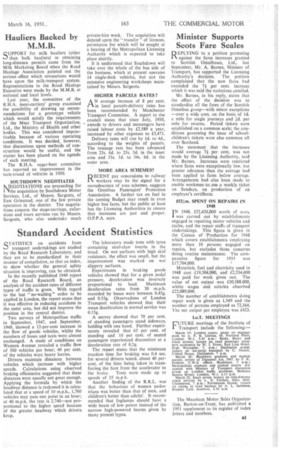Standard Accident Statistics
Page 35

If you've noticed an error in this article please click here to report it so we can fix it.
QTATIST1CS on accidents from
transport undertakings are studied by the Road Research Laboratory, and they are to be standardized in their manner of compilation, so that an index, to show whether the general safety situation is improving, can be obtained.
In the recently published 1949 report of the Road Research Board, an analysis of the accident rates of different types of traffic is given. With regard to the last "no-waiting" order to be applied in London, the report states that it was effective in reducing accidents in the outer area, but did not improve the position in the central district. Two surveys of Metropolitan traffic in September, 1947, and . September, 1949, showed a 12-per-cent increase in the flow of goods vehicles, whilst the numbers of buses and taxis were almost unchanged. A study of conditions on Western Avenue revealed a traffic flow of 500 vehicles per hour; 40 per cent, of the vehicles were heavy lorries.
Drivers maintain distances between vehicles which increase with higher speeds. Calculations using observed braking efficiencies suggested that these distances were usually not great enough. Applying the formula by which the headway distance is reckoned it is calculated that at a speed of 10 m.p.h., 1,760 vehicles may pass one point in an hour; at 40 m.p.h. the rate is 2,740—not proportional to the higher speed because of the greater headway which drivers keep.
The laboratory made tests with tyres containing steel-claw inserts in the tread. On wet surfaces with high skid resistance, the effect was small, but the improvement was marked on wet slippery surfaces.
Experiments in braking goods vehicles showed that for a given pedal pressure, deceleration was inversely proportional to load. Maximum deceleration rates from 30 m.p.h. recorded by buses were between 0.45g. and 0.55g. Observations of London Transport vehicles showed that their mean deceleration in normal service was 0.15g.
A survey showed that 70 per cent. of standing passengers stand sideways, holding with one hand. Further experiments revealed that 65 per cent. of standing and 10 per cent. of seated passengers experienced discomfort at a deceleration rate of 0.2g.
The report states that the minimum reaction time for braking was 0.4 sec. for several drivers tested, about 40 percent. of the time being taken in transferring the foot from the accelerator to the brake. Tests were made up to speeds of 35 m.p.h.
Another finding of the R.R.L. was that the behaviour of women pedestrians was better than that of men, and children's better than adults'. It recommended that foglamps should have a wide beam of low power instead of the narrow high-powered beams given by many present types.




















































































